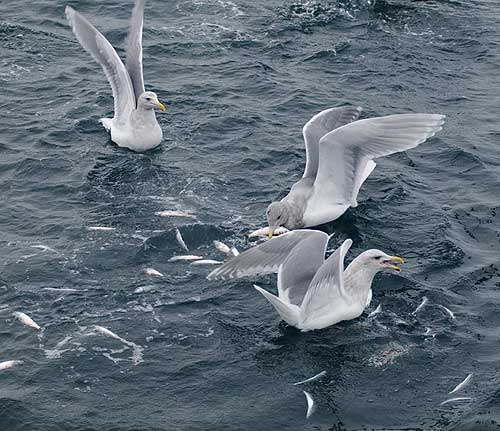
Southeast Alaska Pacific herring ESA listing not warranted
April 04, 2014
According to a NOAA news release, this listing determination decision comes after an extensive status review based on the best scientific and commercial information available.
Gulls feed on hundreds of stunned herring brought to the surface by a humpback whale. By disrupting herring aggregations at depth, whales make herring available to other air breathing predators with limited diving abilities.
The 2008 status review found that Lynn Canal Pacific herring are part of a larger Southeast Alaska Distinct Population Segment (DPS) of Pacific herring, which should be considered a candidate species under the ESA. NOAA Fisheries then began a status review of the Southeast Alaska Distinct Population Segment (DPS) of Pacific herring. Following the new status review of the larger Southeast Alaska population, NOAA Fisheries has found that listing the Southeast Alaska Distinct Population Segment under the ESA is not warranted at this time. Herring in Southeast Alaska have shown a positive trend in abundance between 1980 and 2011, and are exhibiting positive trends in growth rate and productivity. Although local spawning aggregations may periodically exhibit low levels of abundance, these aggregations appear to rebuild in time, possibly due to immigration from other areas. While there are some threats from habitat loss in urban areas, NOAA Fisheries concluded that Pacific herring in Southeast Alaska are not likely to become endangered within the foreseeable future. The Southeast Alaska Distinct Population Segment (DPS) of Pacific herring extends from Dixon Entrance in the south, where it is genetically distinguished from the British Columbia stock; to Cape Fairweather and Ice Point in the north, where the stock is limited by physical and ecological barriers. Herring are a keystone species in Southeast Alaska, playing a central role in marine food webs and also of significant importance as a commercial and subsistence species in many communities. Regulations pertaining to the herring fishery are adopted by the Alaska Board of Fisheries, after consideration of social, political, and economic factors, as well as scientific input from Alaska Department of Fish & Game.
|
||
